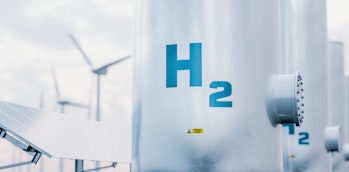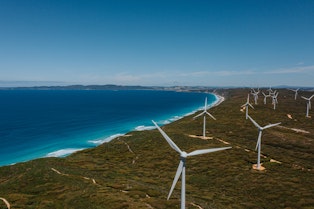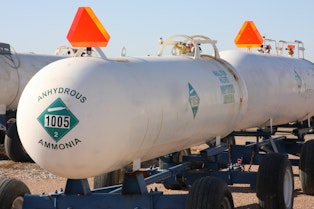George Soros, the billionaire hedge fund manager, once said: "The smart money doesn't chase trends; it sets them.” I believe we’re seeing that play out in front of our eyes with hydrogen.
It is no secret that Australia is setting a course for a hydrogen-enriched future. The federal government issued a National Hydrogen Strategy in 2019 and announced AUD$2 billion for a Australia’s Hydrogen Headstart program in the 2023 budget, to make sure Australia is still on track to be a global hydrogen leader by 2030.
And the smart money is leading the charge, with Andrew ‘Twiggy’ Forrest’s Fortescue Future Industries working towards the development of a sustainable hydrogen industry, focusing on green hydrogen production and global supply chain development. Meanwhile oil giant BP has acquired land in Western Australia, for AUD$23 million, to build a hydrogen hub.

In this article, I explore:
- Hydrogen production as a viable alternative to coal and gas which will need to be phased out for global climate targets to be met.
- How green hydrogen production using renewable energy sources such as solar and wind is gaining momentum, and Australia, with its abundance of low-cost renewable energy, is well-positioned to capitalize on this opportunity.
- Why the transportation of hydrogen poses challenges due to its gaseous nature, requiring either compression or liquefaction. Ammonia, derived from hydrogen, presents a more feasible option for shipping and storing hydrogen, leveraging existing infrastructure and potential markets in sectors like fertilizer production.
- The crucial need to develop renewable generation and energy storage for green hydrogen production to ensure Australia maintains its competitive edge.
Fostering hydrogen production makes a lot of sense for Australia. Coal and gas are Australia’s second- and third-largest sources of export revenue, according to figures from the Australian government. But these sources of fuel are fast going out of fashion. By 2050, if global climate targets are to be met, virtually all the coal and most of the gas in worldwide energy systems will have to be phased out.
Even the demand for fossil fuels from the plastics industry is likely to be greatly diminished as the sector moves to circular methods of production. That won’t mean the end of molecular fuels, though.
While the energy transition will require a massive global shift towards electric power supplied by renewables, not all industries can be decarbonized through electrification. Long-haul flights and oceanic shipping, for example, cannot run on battery power.
And industries that rely on process heat will need to have something to burn. In the absence of coal or gas, what will it be? The smart money is on hydrogen, the most abundant element in the universe. Hydrogen is already produced at scale, albeit from methane with a large carbon footprint.
In future, though, the expectation is that hydrogen production will follow one or more of several low-carbon production pathways. One is the take today’s steam methane reforming process and use carbon capture and storage to take care of the emissions.

Another—likely to be the most important pathway in the long run—is to use renewable energy such as solar and wind for the electrolysis of water. This produces oxygen as a by-product and results in what is known as green hydrogen. Demand for this green hydrogen is already emerging in markets such as Japan.
And as the energy transition gathers speed, several countries are jostling to become green hydrogen suppliers. It is not something that any country can do, however. The main requirement is for plentiful low-cost renewable energy, something that Australia has lots of.
And with the addition of battery storage, which Australia is also looking to produce in bulk, even intermittent renewable energy sources such as solar can provide power almost around the clock, maximizing the production of green hydrogen.
This means green hydrogen could be produced cheaply and in large quantities—just what is needed to build an export industry that could replace coal and gas. However, there is a catch.
Whereas coal and natural gas can be stored and shipped with relative ease, hydrogen is a much trickier proposition. As a molecule, it likes having space to move around. This means you need much bigger tanks to carry hydrogen than natural gas.
So much bigger, in fact, that it simply does not make sense to store or ship hydrogen in gaseous form at normal temperature and pressure. Instead, the gas would either have to be massively compressed, or chilled to a liquid, or both.
This requires a lot of energy, reducing the efficiency of hydrogen as a fuel, and even then may not overcome the transportation problems. For storage, hydrogen must be compressed to around 200 atmospheres, requiring containers that cannot be used cost-effectively in shipping.
To become a liquid, meanwhile, hydrogen must be cooled to below minus 240 degrees Celsius. At this temperature, gases such as nitrogen and oxygen will also freeze, so the hydrogen storage tanks and associated equipment must be housed in a vacuum.
Even with the best insulation, it will be impossible to prevent a certain amount of liquid hydrogen from boiling off. All this makes hydrogen a poor candidate for global trade, which is why most projects today foresee using hydrogen close to the site of production.
But there is another option for shipping that could be more viable. Take three atoms of hydrogen, add one of nitrogen and you have ammonia, a compound that is already shipped around the world as a precursor for fertilizer production.

Ammonia is not a perfect substance by any stretch of the imagination. It is highly corrosive and is much less energy dense than fossil fuels such as liquified natural gas (LNG), so it requires much larger containers than LNG to transport a given amount of fuel.
However, the fact that it is already a widely traded commodity is an important benefit. Ammonia made from low-carbon hydrogen could be shipped today because there are vessels and storage facilities around the world that are already designed to handle it.
Ammonia can also act as a replacement fuel for applications where space is not too much of an issue, such as in shipping. In future, when the technology has been perfected and scaled up, ammonia molecules could be cracked open to release their hydrogen. This process, which is not cost effective at present, would allow ammonia to act as a hydrogen carrier so the gas can be transported worldwide from production centres in Australia.
Today this is not necessary because there is already emerging demand for low-carbon ammonia, predominantly to help decarbonize fertilizer production. About 80% of ammonia production today is for fertilizer, with the remainder going into applications such as refrigeration, water purification and the manufacturing of plastics, explosives, fabrics, pesticides, dyes and chemicals, as well as cleaning products. Given the size of the global fertilizer market, this is a vast opportunity for Australia’s nascent green hydrogen industry.
But Australia is not the only country eyeing this market: regions such as the Middle East are also looking to use low-cost renewable generation to create green hydrogen and then ammonia.
To remain ahead, Australia must put infrastructure in place as quickly as possible, starting with renewable generation and energy storage relating specifically to green hydrogen production.
If Australia is to reach ‘hydrogen superpower’ status, it will need to invest AUD$739 billion on building 812 GW of renewables, according to analyst firm BloombergNEF.
This would allow Australia to meet around 6% of global hydrogen demand by 2050, but the numbers are “truly mind-boggling,” says PV Magazine.
The message is clear: ammonia can help Australia achieve hydrogen leadership but there is no time to waste in building out the renewable and storage infrastructure that will be required.
Publish date: 26 June, 2023